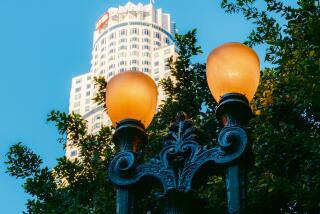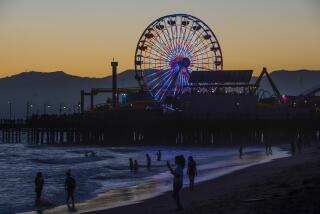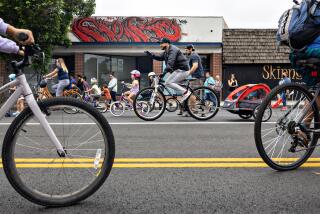Op-Ed: Let there be (less) light

The view of downtown Los Angeles from the Griffith Park Observatory.
Looking out across Los Angeles from Mt. Wilson Observatory at night, the hills and mountains look like islands in a sea of light. It was here that Edwin Hubble first proved our universe was expanding at a rapid pace. From this vantage point you can still make out the major constellations, but drive into the light bubble and suddenly the cosmos feels awfully far away. The city shines so bright it blocks out the stars, a phenomenon known as “skyglow.”
Light seeps into the sky from stadiums, malls, parking lots, offices and billboards. But streetlights, with their harsh bulbs, are the worst offenders.
The 215,000 streetlights in Los Angeles are meant to thwart more than fumbled keys and stubbed toes — they’re a luminous security blanket, or so the Los Angeles Bureau of Street Lighting would have you believe. The bureau’s slogan: “Bright Lights, Safe Nights.” Other cities use the motto too.
We intuitively assume that more lights mean less crime. Indeed, police are often taught that, second to more cops, good lighting is the best crime deterrent.
Yet decades of research show there’s no scientific reason to believe that darker streets are inherently more dangerous. And, increasingly, researchers are finding that excess light is toxic for both humans and wildlife.
In one study, published July 28 in the Journal of Epidemiology and Community Health, researchers examined 14 years of data from 62 local authorities across England and Wales, hunting for crime and collision trends among agencies that reduced their lighting.
England’s councils — local governing bodies — have sought to slash costs and carbon emissions in recent years under pressure from the national government. In response, 106 councils either dimmed or turned off some streetlights, affecting an estimated 750,000 lamps altogether.
Not everyone is happy about the darker skies. The “great streetlight switch-off” has sparked a political debate, with the country’s automobile association asserting that six people have died since 2009 as a direct result and opposition politicians rushing to lay blame.
But the health researchers found no link between collisions and lighting despite studying about 14,500 miles of roadways where streetlights were dimmed, lighted for only part of the night or shut off entirely. They also examined lighting’s effect on crime and similarly found no increase in burglary, auto theft, robbery, violence or sexual assault in areas where lighting policy had changed.
The scientists published a companion study based on surveys of 520 people living in darkened areas. Many residents said they didn’t even notice the dimming, let alone feel threatened by an uptick in crime.
Other studies back up these results. In 1998, for example, Chicago tried to fight crime with a three-phase plan that included upgrading 175,000 streetlights, as well as lights in transit stations and alleys around the city. The city kept experimental control areas unchanged and found that crime consistently increased in both the well-lighted and the control areas. Illinois criminal justice officials concluded that strolling down a dark alley was no more dangerous than doing so in a well-lighted one.
All this should make taxpayers uneasy. Last week, the Cities at Night project released a report estimating that the European Union alone spends about $7 billion annually to power streetlights.
But there’s something much more troubling than wasted money about losing the night. A growing body of biological research suggests that nighttime lighting messes with the circadian rhythms of humans and other animals, wreaking havoc on everything from sleep patterns to DNA repair.
Studies have shown that nighttime light exposure is a risk factor for some cancers, diabetes, heart disease and obesity. As scientists continue to gather evidence, the American Medical Assn. has already recommended that cities reduce light pollution and that people avoid staring at electronic screens after dark.
LEDs are of particular concern. Cities around the world are converting from traditional yellow sodium-vapor lamps, which cast their light in a narrow range, to broad-spectrum LED streetlights. Los Angeles has installed 165,000 LEDs in recent years, slashing streetlight energy use by 60% and netting $8 million in energy savings annually.
The problem is that these bright lamps increase skyglow by emitting more blue light than the older technology. They also could have unintended effects on wildlife. Artificial lights can disrupt navigation, mating and feeding among the many nocturnal animals that share our cities.
A University of Bristol study published this month showed that certain moths can’t perform evasive maneuvers against predatory bats under LEDs. And recent research in New Zealand shows some insects are 48% more attracted to the new LEDs than they were to the old-fashioned lights. The researchers worry that widespread use of the new technology will create a “white-light night” that intensifies light pollution’s pressure on ecosystems.
The psychological loss is less measurable.
When the 1994 Northridge earthquake hit, some area residents actually called 911 to report a strange cloud hovering overhead — it was the Milky Way, the nebulous and star-rich center of our galaxy.
What happens when people grow up without stars? Do they lose their connection to the cosmos that our ancestors tracked so carefully, night after night?
Eric Betz is an editor for Astronomy magazine.
Follow the Opinion section on Twitter @latimesopinion and Facebook
More to Read
A cure for the common opinion
Get thought-provoking perspectives with our weekly newsletter.
You may occasionally receive promotional content from the Los Angeles Times.






